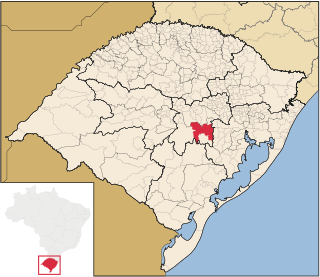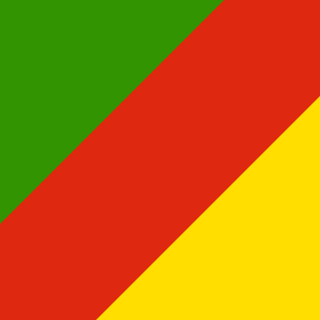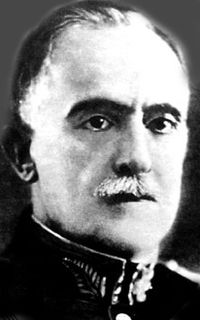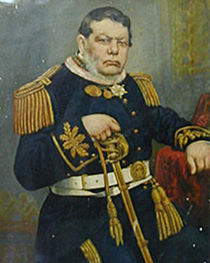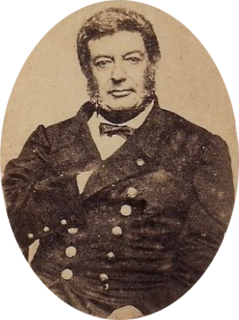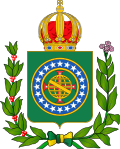José Luís Mena Barreto | |
|---|---|
 José Luís Mena Barreto around age 49, c.1866 | |
| Born | 24 October 1817 Rio Grande do Sul, Kingdom of Brazil |
| Died | 10 October 1879 (aged 61) Porto Alegre, Rio Grande do Sul, Empire of Brazil |
| Allegiance | |
| Rank | Field marshal |
| Battles/wars | |
José Luís Mena Barreto (24 October 1817 – 10 October 1879) was an army officer, politician and monarchist of the Empire of Brazil. He came from a wealthy family with a tradition of military service. José Luís entered the army in 1836, during the Ragamuffin War, a secessionist rebellion. The conflict lasted for almost ten years, and he fought in several military engagements at that time.
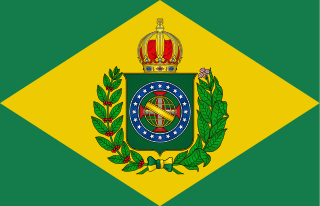
The Empire of Brazil was a 19th-century state that broadly comprised the territories which form modern Brazil and Uruguay. Its government was a representative parliamentary constitutional monarchy under the rule of Emperors Dom Pedro I and his son Dom Pedro II. A colony of the Kingdom of Portugal, Brazil became the seat of the Portuguese colonial Empire in 1808, when the Portuguese Prince regent, later King Dom João VI, fled from Napoleon's invasion of Portugal and established himself and his government in the Brazilian city of Rio de Janeiro. João VI later returned to Portugal, leaving his eldest son and heir, Pedro, to rule the Kingdom of Brazil as regent. On 7 September 1822, Pedro declared the independence of Brazil and, after waging a successful war against his father's kingdom, was acclaimed on 12 October as Pedro I, the first Emperor of Brazil. The new country was huge but sparsely populated and ethnically diverse.

The Ragamuffin War was a Republican uprising that began in southern Brazil, in the state of Rio Grande do Sul in 1835. The rebels, led by generals Bento Gonçalves da Silva and Antônio de Sousa Neto with the support of the Italian fighter Giuseppe Garibaldi, surrendered to imperial forces in 1845.
Contents
- Early years
- Early military career
- Ragamuffins rebellion
- Platine War
- Southern wars
- Invasion of Uruguay
- War against Paraguay
- Later years and death
- Honors
- Non-titled nobility honors
- Military honors
- See also
- References
- Bibliography
José Luís held several positions during the years following the end of the Ragamuffin threat in 1845. His most important posting was command over the cavalry unit that served as Emperor Dom Pedro II's personal guard in the national capital, Rio de Janeiro. He also fought against the Argentine Confederation in the brief Platine War, which lasted from 1851 until 1852. In 1864, he led one of the two divisions which comprised the Brazilian army in the Uruguayan War. During that conflict, he led the initial invasion of Uruguay and fought in two crucial engagements that resulted in the capture of two Uruguayan towns.

Dom Pedro II, nicknamed "the Magnanimous", was the second and last monarch of the Empire of Brazil, reigning for over 58 years. He was born in Rio de Janeiro, the seventh child of Emperor Dom Pedro I of Brazil and Empress Dona Maria Leopoldina and thus a member of the Brazilian branch of the House of Braganza. His father's abrupt abdication and departure to Europe in 1831 left the five year-old as Emperor and led to a grim and lonely childhood and adolescence, obliged to spend his time studying in preparation for rule. He knew only brief moments of happiness and encountered few friends of his age. His experiences with court intrigues and political disputes during this period greatly affected his later character; he grew into a man with a strong sense of duty and devotion toward his country and his people, yet increasingly resentful of his role as monarch.

Rio de Janeiro, or simply Rio, is anchor to the Rio de Janeiro metropolitan area and the second-most populous municipality in Brazil and the sixth-most populous in the Americas. Rio de Janeiro is the capital of the state of Rio de Janeiro, Brazil's third-most populous state. Part of the city has been designated as a World Heritage Site, named "Rio de Janeiro: Carioca Landscapes between the Mountain and the Sea", by UNESCO on 1 July 2012 as a Cultural Landscape.

The Argentine Confederation was the last predecessor state of modern Argentina; its name is still one of the official names of the country according to the Argentine Constitution, Article 35. It was the name of the country from 1831 to 1852, when the provinces were organized as a confederation without a head of state. The governor of Buenos Aires Province managed foreign relations during this time. Under his rule, the Argentine Confederation resisted attacks by Brazil, Bolivia, Uruguay, France and the UK, as well as other Argentine factions during the Argentine Civil Wars.
In the Paraguayan War, José Luís fought in most of its decisive campaigns. He was severely wounded during one battle and was left disfigured. Despite having served from 1864 until 1870 as a successful field commander, José Luís was repeatedly passed over in promotions and was not awarded a title of nobility. After the war, he held bureaucratic positions in military units before settling in the highly prestigious post of military commander of his native province, Rio Grande do Sul. He was also a politician and member of the Liberal Party. José Luís was seen by contemporaries and, after his death in 1879, by historians as a brave and able field commander.

The Paraguayan War, also known as the War of the Triple Alliance and the Great War in Paraguay, was a South American war fought from 1864 to 1870, between Paraguay and the Triple Alliance of Argentina, the Empire of Brazil, and Uruguay. It was the deadliest and bloodiest inter-state war in Latin America's history. It particularly devastated Paraguay, which suffered catastrophic losses in population: almost 70% of its adult male population died, according to some counts, and it was forced to cede territory to Argentina and Brazil. According to some estimates, Paraguay's pre-war population of 525,000 was reduced to 221,000, of which only 28,000 were men.

Nobility is a social class normally ranked immediately under royalty and found in some societies that have a formal aristocracy. Nobility possesses more acknowledged privileges and higher social status than most other classes in society. The privileges associated with nobility may constitute substantial advantages over or relative to non-nobles, or may be largely honorary, and vary by country and era. As referred to in the Medieval chivalric motto "noblesse oblige", nobles can also carry a lifelong duty to uphold various social responsibilities, such as honorable behavior, customary service, or leadership positions. Membership in the nobility, including rights and responsibilities, is typically hereditary.

Rio Grande do Sul is a state located in the southern region of Brazil. It is the fifth most populous state and the ninth largest by area. Located in the southernmost part of the country, Rio Grande do Sul is bordered clockwise by Santa Catarina to the north and northeast, the Atlantic Ocean to the east, the Uruguayan departments of Rocha, Treinta y Tres, Cerro Largo, Rivera and Artigas to the south and southwest, and the Argentine provinces of Corrientes and Misiones to the west and northwest. The capital and largest city is Porto Alegre. The state has the highest life expectancy in Brazil, and the crime rate is considered to be low.




